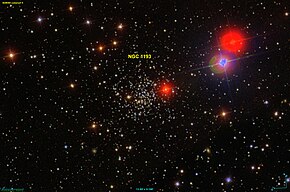
Messier 52 or M52, also known as NGC 7654 or the Scorpion Cluster, is an open cluster of stars in the highly northern constellation of Cassiopeia. It was discovered by Charles Messier in 1774. It can be seen from Earth under a good night sky with binoculars. The brightness of the cluster is influenced by extinction, which is stronger in the southern half. Its metallicity is somewhat below that of the Sun, and is estimated to be [Fe/H] = −0.05 ± 0.01.

NGC 381 is an open cluster of stars in the northern constellation of Cassiopeia, located at a distance of approximately 3,120 light-years from the Sun. Credit for the discovery of this cluster was given to Caroline Herschel by her brother William in 1787, although she may never have actually seen it.

NGC 2204 is an open cluster of stars in the Canis Major constellation. It was discovered by the German-English astronomer William Herschel on 6 February 1785. The cluster has an integrated visual magnitude of 8.6 and spans a diameter of 10.0′. Resolving the individual member stars is a challenge with a 10 to 12-inch amateur telescope. It is located at a distance of approximately 13,400 light years from the Sun. The cluster shows a mean radial velocity of +91.38±0.30 km/s relative to the Sun, and is orbiting the inner galactic disk region about 1 kpc below the galactic plane.

NGC 1502 is a young open cluster of approximately 60 stars in the constellation Camelopardalis, discovered by William Herschel on November 3, 1787. It has a visual magnitude of 6.0 and thus is dimly visible to the naked eye. This cluster is located at a distance of approximately 3,500 light years from the Sun, at the outer edge of the Cam OB1 association of co-moving stars, and is likely part of the Orion Arm. The asterism known as Kemble's Cascade appears to "flow" into NGC 1502, but this is just a chance alignment of stars.
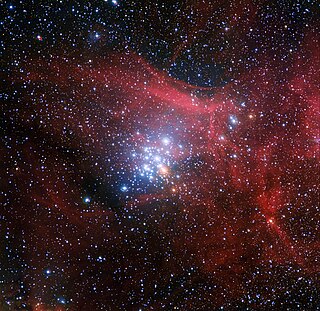
NGC 3293 is an open cluster in the Carina constellation. It was discovered by Nicolas-Louis de Lacaille in 1751. It consists of more than 100 stars brighter than 14th magnitude in a 10 arc minute field, the brightest of which are blue supergiants of apparent magnitude 6.5 and 6.7. There is also a 7th magnitude pulsating red supergiant, V361 Carinae.

NGC 6250 is a open cluster of stars in the southern constellation of Ara, near the border with Scorpius. It was discovered by English astronomer John Herschel on July 1, 1834. This cluster has an apparent visual magnitude of 5.9 and spans an angular diameter of 18′, with the brightest member being of magnitude 7.6. About 15 members are visible with binoculars or a small telescope. NGC 6250 is located at a distance of 2,820 ly (865 pc) from the Sun, and is approaching with a mean radial velocity of −10±6 km/s.

NGC 2374 is an open cluster of stars in the Canis Major constellation. It was discovered on January 31, 1785 by the German-British astronomer William Herschel. This cluster is relatively rich in stars but is scattered across an angular diameter of 19.0′. It has an integrated visual magnitude of 8.0 and can be viewed with a modest amateur telescope. NGC 2374 is located at a distance of approximately 3,950 light-years (1,212 pc) from the Sun.

NGC 637 is an open cluster of stars in the northern constellation of Cassiopeia, positioned about 1.5° to the WNW of the star Epsilon Cassiopeiae. The cluster was discovered on 9 November 1787 by German-born English astronomer William Herschel. It is located in the Perseus Arm of the Milky Way, at a distance of approximately 7.045 kilolight-years from the Sun. The cluster is small but compact, and is readily visible in a small telescope.

NGC 6834 is a young open cluster of stars located about 10,850 light years from the Sun in the constellation Cygnus. It was discovered on July 17, 1784, by Anglo-German astronomer William Herschel. The cluster has a visual magnitude of 7.8, which is dimmed by 2.1 magnitudes due to interstellar dust. Half the cluster members lie within an angular radius of 6′.
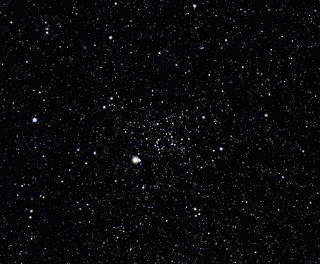
NGC 2539 is an open cluster in the constellation Puppis, located at the north edge of the constellation. It was discovered by William Herschel on January 31, 1785. It is a moderately rich cluster and with little central concentration, with Trumpler class II1m.
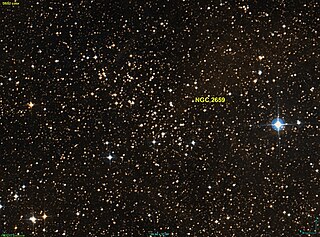
NGC 2659 is an open cluster in the constellation Vela. It was discovered by John Herschel on 3 February, 1835. It is of Trumpler class III3m. It is a young cluster, with age nearly 8 million years. The core of the cluster is 1.93 parsec across and the total radius is 3.6 pc. The total number of stars that belong to the cluster is estimated to be 1,801 ± 608 stars and the total mass 857 ± 237 M☉. Among its members, one is a Be star, with four more possible Be stars.

NGC 5460 is an open cluster in the constellation Centaurus. It is a bright but loose cluster of intermediate age located approximately 2,300 light years away from Earth. It is located nearly 2 degrees east-southeast of Zeta Centauri.

NGC 5617 is an open cluster in the constellation Centaurus. NGC 5617 forms a binary open cluster with Trumpler 22. It lies one degree west-northwest of Alpha Centauri.
IC 2714 is an open cluster in the constellation Carina. It was discovered by James Dunlop in 1826. It is located approximately 4,000 light years away from Earth, in the Carina–Sagittarius Arm.
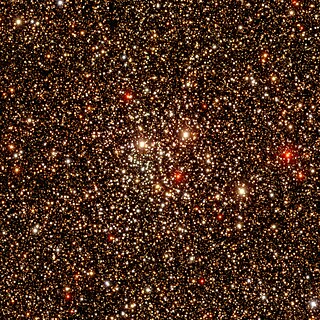
NGC 4815 is an open cluster in the constellation Musca. It was discovered by John Herschel in 1834. It is located approximately 10,000 light years away from Earth.

NGC 2266 is an open cluster of stars in the constellation of Gemini. It was discovered by German-British astronomer William Herschel on 7 December 1785. This is a relatively dim cluster with an integrated visual magnitude of 9.5 and an angular size of 5.0′. The stellar members can be readily resolved with an amateur telescope. NGC 2266 is located at a distance of 10,603 ly (3,251.0 pc) from the Sun. It is located close to the opposite part of the sky from the Galactic Center, or the anti-center.

NGC 2527 is an open cluster in the constellation Puppis. It was discovered by William Herschel on December 9, 1784. The cluster was also observed by John Herschel on January 7, 1831. He also observed it on February 5, 1837, identifying it as a different object, which was catalogued as NGC 2520. It is a poor cluster and with no central concentration, with Trumpler class III1p.

NGC 7160 is an open cluster in the constellation Cepheus. It was discovered by William Herschel on November 9, 1789. The cluster was also observed by John Herschel on October 7, 1829. It is a poor cluster and with little central concentration, with Trumpler class II3p. It is part of the stellar association Cepheus OB2, located one degree south-southwest of VV Cephei.

Trumpler 27 is a possible open cluster in the southern constellation Scorpius. If it exists, it is a few thousand light-years away from the Sun, with estimates ranging from 3,900 light-years to 6,800 light-years The name refers to Robert Julius Trumpler's catalog of open clusters, published in 1930.

NGC 1513 is an open cluster of stars in the northern constellation of Perseus, positioned 2° SSE of the faint star Lambda Persei. The same telescope field contains the clusters NGC 1528 and NGC 1545. NGC 1513 was discovered in 1790 by the German-British astronomer William Herschel. The brightest component star is of magnitude 11, so a medium-sized amateur telescope is needed to observe 20-30 members. With a 12 in (30 cm) aperture telescope, most of the member stars can be resolved. This cluster is located at a distance of 4,824 light-years from the Sun, but is drawing closer with a radial velocity of −14.7 km/s.
